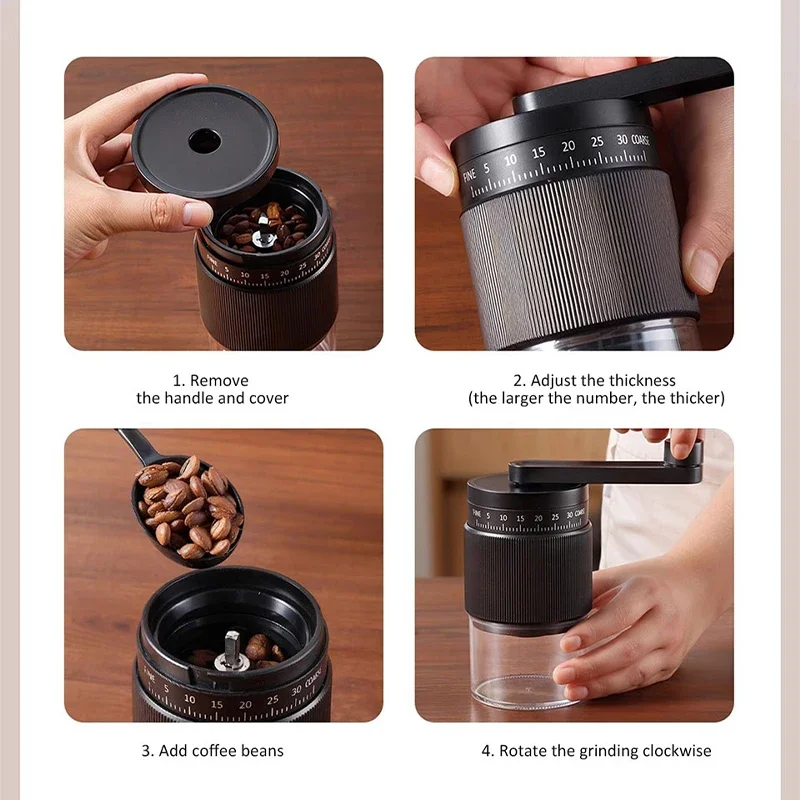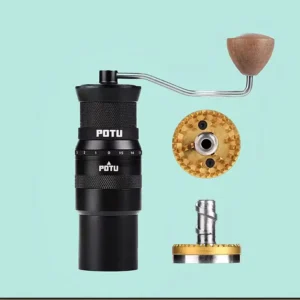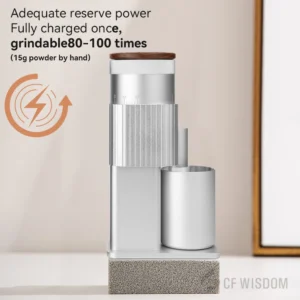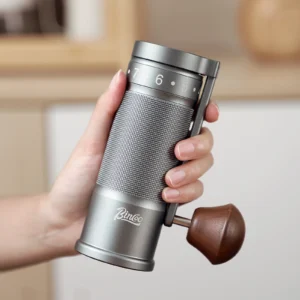Understanding the Importance of Grind Consistency for Perfect Coffee
When your morning brew tastes bitter one day and sour the next, inconsistent coffee grounds may be the culprit. Grind consistency refers to having uniform particle sizes throughout your ground coffee—a critical factor that directly impacts how water extracts flavor from your beans.
Think of coffee grounds like puzzle pieces. When they’re all similar in size, water flows through them evenly, extracting flavors at the same rate. But when your grinder produces a mixture of fine powder (called “fines”) and larger chunks (“boulders”), problems arise. Those tiny particles over-extract quickly, creating bitterness, while the larger pieces under-extract, contributing sour notes to your cup.
What is grind consistency?
Grind consistency means achieving uniform particle size throughout your ground coffee. When grounds are consistent, extraction happens evenly, resulting in balanced flavor. Inconsistent grounds lead to simultaneous over-extraction (from too-fine particles) and under-extraction (from too-coarse particles).
This inconsistency causes frustrating brewing problems like channeling in espresso (where water finds the path of least resistance through your grounds) and uneven extraction in pour-over methods. Each brewing technique—from French press to espresso—requires different particle sizes, but all benefit from consistency within that size range.
Understanding why your grinder produces inconsistent results is the first step toward better coffee. The good news is that many common causes have straightforward solutions. Whether you’re dealing with worn burrs, alignment issues, or simple maintenance needs, mastering grind consistency in hand burr grinders makes a noticeable difference in your daily cup.
Grinder Types and Their Effect on Consistency
Before diagnosing specific problems, it’s important to understand how different grinder types perform regarding consistency.
Blade Grinders: Inherent Consistency Challenges
Blade grinders operate using a spinning blade that chops beans—similar to how a blender works. This chopping action inherently creates inconsistency because:
– Beans near the blade get chopped multiple times while others receive fewer cuts
– The chopping motion creates heat that can affect flavor
– There’s no mechanism to control particle size other than grinding duration
With blade grinders, even perfect technique will produce a mix of particle sizes—from powder-fine to nearly whole bean fragments. While they’re affordable entry points to fresh-ground coffee, their design limits consistency potential.
Burr Grinders: The Consistency Standard
Burr grinders crush beans between two surfaces (burrs) with precisely cut grooves. This crushing mechanism offers significantly better consistency:
| Burr Type | Consistency Characteristics | Best For |
|---|---|---|
| Flat Burr | Very uniform particle size, excellent for espresso | Precision brewing methods |
| Conical Burr | Good consistency with some fines, versatile | All brewing methods |
Even quality burr grinders face consistency challenges. Manual versions may suffer from inconsistent grinding speed or pressure, while electric models can experience motor speed fluctuations. The precision engineering in flat burr grinders for exceptional coffee provides excellent particle uniformity, making them popular among enthusiasts who prioritize consistency.
If you’re considering upgrading your equipment, exploring different manual coffee burr grinders can significantly improve your brewing consistency without the cost of high-end electric models.
The Top 6 Causes of Inconsistent Grinding in Burr Grinders
Before diving into detailed troubleshooting, let’s identify the six most common culprits behind inconsistent grinding:
- Burr-related problems – Worn, misaligned, or damaged burrs directly affect grind quality
- Cleaning and maintenance issues – Built-up residue interferes with grinding mechanisms
- Grind setting and calibration problems – Incorrect settings or calibration issues create inconsistency
- Mechanical and operational factors – Speed variations and component issues affect performance
- Coffee bean characteristics – Different roasts and freshness levels grind differently
- User technique and environmental factors – How you use your grinder matters
These factors often interact with each other. For instance, oily beans can accelerate residue buildup, which then affects burr performance. Understanding these relationships helps target the specific combination of issues affecting your grinder.
1. Burr-Related Problems
The burrs—those precision-engineered grinding surfaces—are the heart of your grinder. When they develop problems, consistency suffers immediately.
Worn or Dull Burrs
Burrs don’t last forever. Through normal use, their cutting edges gradually dull, leading to:
– Increased production of fine particles (“fines”)
– Longer grinding times for the same amount of coffee
– A noticeable change in cup flavor over time
– Difficulty achieving fine grinds for espresso
Different burr materials have varying lifespans. Steel burrs typically last through 500-1,000 pounds of coffee before showing significant wear, while ceramic burrs may handle slightly more but are more prone to chipping.
Burr Misalignment
Properly aligned burrs should be perfectly parallel, with an even gap between them at all points. Misalignment happens when:
– The grinder has been dropped or bumped
– It was reassembled incorrectly after cleaning
– Manufacturing defects are present
– Mounting screws have loosened over time
Symptoms include:
– Grinding noises that sound like metal scraping
– Visibly uneven grounds when examined closely
– Inconsistent extraction despite consistent technique
– Difficulty adjusting to certain grind settings
The “marker test” is a simple way to check alignment: mark the edge of one burr with washable marker, then turn the other burr briefly against it. The marker should transfer evenly if alignment is good.
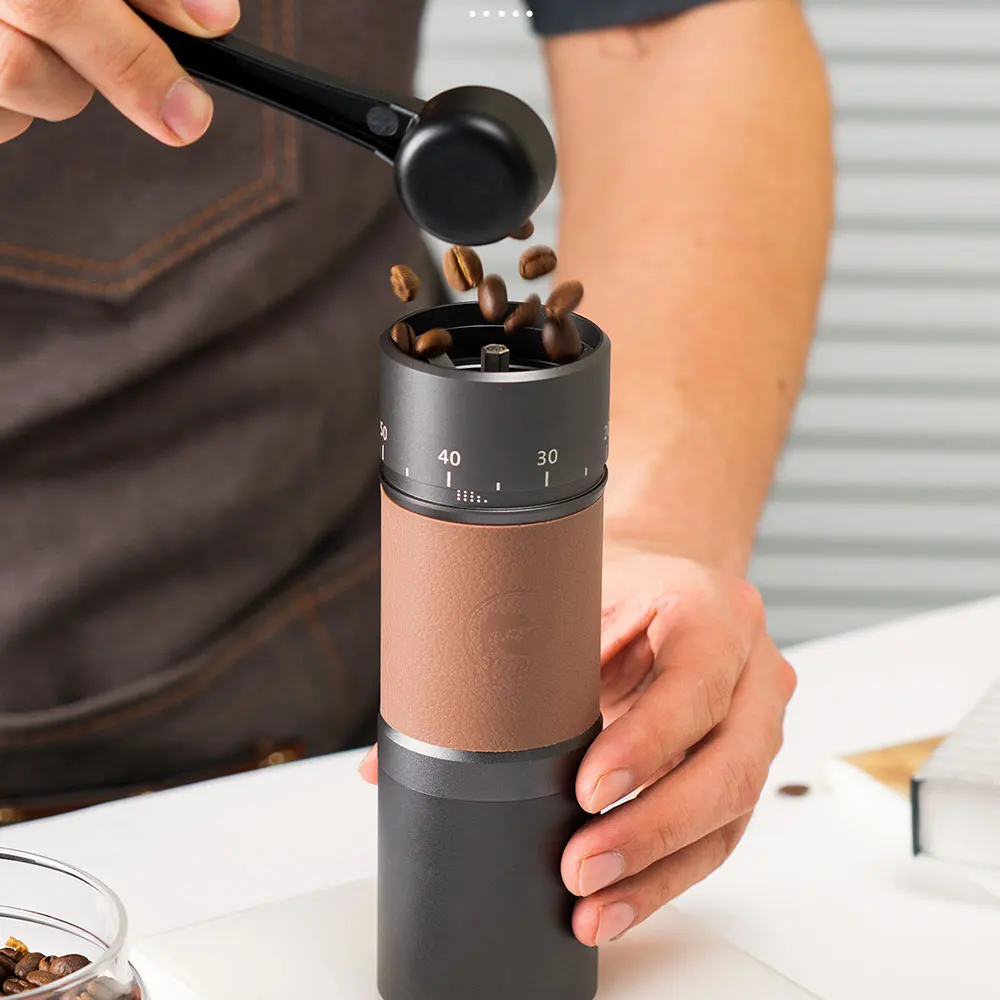
For those wanting deeper understanding, learning about the critical impact of burr alignment on coffee explains why this factor so dramatically affects cup quality. If you discover alignment issues, considering flat burr hand grinders designed with better alignment systems may be worthwhile.
Damaged or Defective Burrs
Sometimes, burrs develop specific damage that creates consistency problems:
– Small chips from foreign objects (stones in beans)
– Cracks from dropping the grinder
– Manufacturing defects that weren’t initially noticeable
– Corrosion from improper cleaning or storage
Inspect your burrs carefully under good lighting. Any visible damage, especially to the cutting edges, can create “dead zones” that produce inconsistent particles.
2. Cleaning and Maintenance Issues
Even perfect burrs can’t deliver consistency when hampered by buildup and maintenance issues.
Coffee Oils and Residue Build-up
Coffee beans contain oils that gradually accumulate on burrs and other grinder components:
– Oils become sticky, trapping fine particles
– These trapped particles disrupt the flow of grounds
– Older oils become rancid, affecting flavor
– Buildup changes the effective distance between burrs
This buildup occurs primarily:
– On the flat surfaces and edges of burrs
– In the grounds chute where coffee exits
– Around adjustment mechanisms
– In the grounds chamber
Static Electricity Problems
Static electricity naturally develops during grinding and causes:
– Fine particles to cling to surfaces instead of falling into your brewing device
– Uneven distribution as grounds clump together
– Inconsistent dosing when particles remain in the grinder
– Grounds spraying when dispensed (the “sneeze effect”)
Static worsens in dry conditions and with certain bean types. If you notice grounds clinging to everything or distributing unevenly, static is likely contributing to your consistency problems.
Neglected Maintenance Points
Beyond just the burrs, other areas need regular attention:
– Bearing surfaces that support the burrs
– Thread mechanisms in adjustment systems
– Gaskets and seals that prevent grounds from escaping
– Drive mechanisms in electric models
Regular maintenance for coffee grinders prevents minor issues from becoming major problems. For those seeking equipment that maintains consistency longer, precision manual grinders often feature design elements that make regular maintenance easier.
3. Grind Setting and Calibration Problems
Sometimes, what appears to be inconsistency is actually a setting or calibration issue.
Inappropriate Grind Settings
Each brewing method requires a specific grind size range:
– Espresso: Fine, like table salt
– Pour-over: Medium, like sand
– French press: Coarse, like sea salt
Using too fine a setting for a brewing method that requires coarse grounds (or vice versa) creates what seems like consistency problems but is actually an inappropriate setting choice.
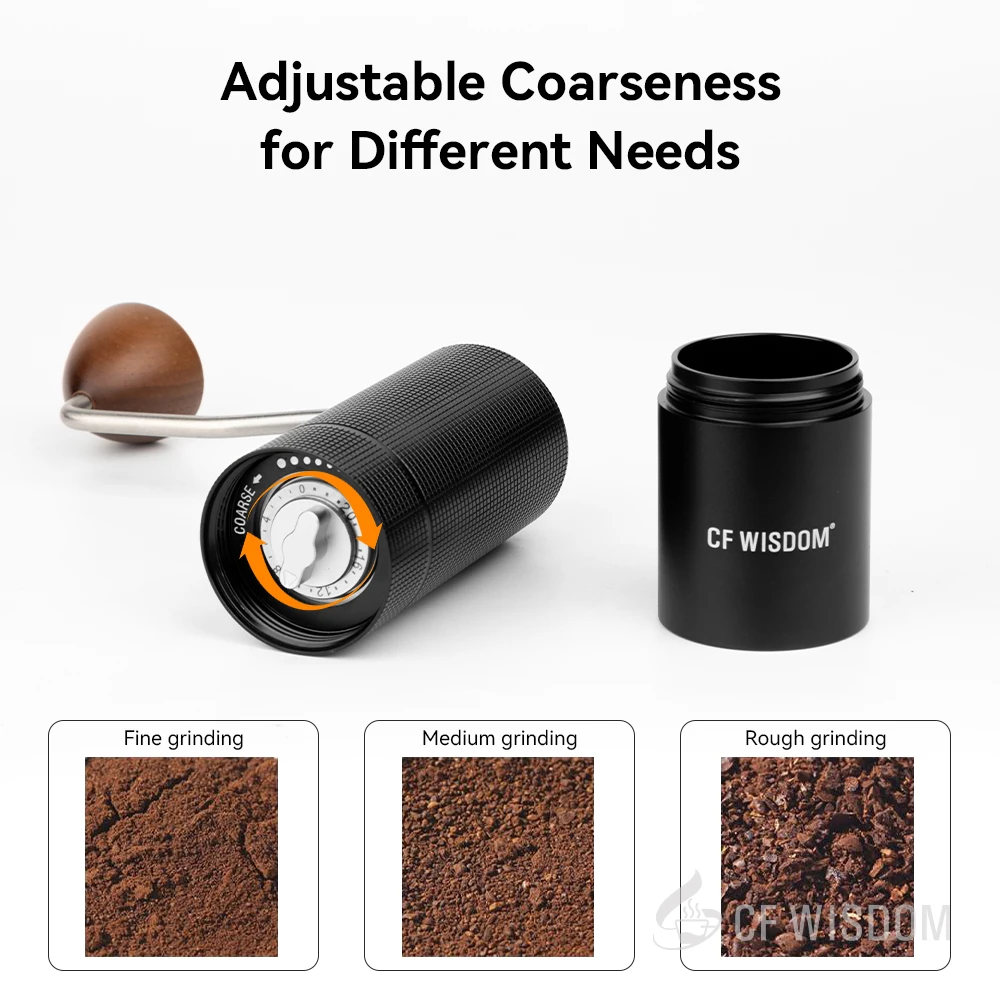
Grind Setting Slippage
Some grinders suffer from setting drift during operation:
– Vibration loosens the adjustment mechanism
– The setting gradually shifts during grinding
– Springs or tensioners weaken over time
– Threaded adjusters back off with use
Signs of setting drift include:
– Grounds becoming noticeably finer or coarser during grinding
– Having to readjust frequently
– Inconsistent results despite consistent technique
Calibration Inaccuracies
Grinders need proper calibration to ensure settings are meaningful:
– The “zero point” (where burrs touch) must be accurately established
– Stepped grinders need proper indexing
– Setting markers should align with actual grind sizes
– Factory calibration may shift during shipping or early use
Understanding zero hand grinder calibration techniques helps ensure your grinder produces the particle size you expect when you select a particular setting.
4. Mechanical and Operational Factors
The physical operation of your grinder significantly impacts consistency.
Motor and Speed Issues
In electric grinders, motor performance directly affects consistency:
– Fluctuating speeds create varying particle sizes
– Motors that bog down under load produce inconsistent results
– Voltage issues can cause speed variations
– Heating during extended use affects performance
With manual grinders, human factors create similar issues:
– Varying cranking speed affects how beans feed into burrs
– Inconsistent pressure during grinding
– Fatigue during grinding causing speed changes
– Stopping and starting mid-grind
Component Stability Problems
Internal components must remain stable for consistent grinding:
– Loose burr carriers create wobble and misalignment
– Worn bearings allow shaft movement
– Excessive vibration creates inconsistent grinding pressure
– Drive shaft wear in manual grinders causes wobble
For those interested in technique improvements, learning about achieving uniform grind with manual burrs can help overcome some of these challenges. For long-term solutions, stainless steel manual coffee grinders typically offer better component stability.
Bean Feeding Irregularities
How beans enter the burrs affects consistency:
– “Popcorning” (beans bouncing) creates variable pressure
– Inconsistent bean flow into the grinding chamber
– Low bean levels in hoppers causing irregular feeding
– Single-dosing issues with certain grinder designs
Grind Retention Issues
Grounds that remain in the grinder between uses cause problems:
– Old grounds mix with fresh ones
– Inconsistent dosing as some grounds stay behind
– Channels form in retained grounds, affecting flow
– Stale flavor from previously ground coffee
Fine Adjustment Hand Grinder, Precision Manual Grinder, Travel Coffee Grinder
Price range: $185.11 through $494.63 Select options This product has multiple variants. The options may be chosen on the product pageHand Burr Grinder, Hand Crank Coffee Grinder, Manual Espresso Grinder, Portable Coffee Grinder
Price range: $262.72 through $300.22 Select options This product has multiple variants. The options may be chosen on the product pageManual Burr Mill, Manual Coffee Grinder Stainless Steel, Manual Coffee Mill Grinder, Mechanical Coffee Grinder
Price range: $127.26 through $130.32 Select options This product has multiple variants. The options may be chosen on the product pageHand Burr Grinder, Manual Coffee Grinder Stainless Steel, Precision Manual Grinder
Price range: $183.64 through $187.52 Select options This product has multiple variants. The options may be chosen on the product page
5. Coffee Bean Characteristics Affecting Consistency
Not all inconsistency comes from the grinder itself—sometimes it’s the coffee beans.
Roast Level Challenges
Different roast levels present varying grinding challenges:
– Light roasts are harder and denser, requiring more force
– Dark roasts are more brittle and produce more fines
– Very dark, oily beans can clog grinders with residue
– Mixed roast levels in blends grind inconsistently
Bean Freshness Impacts
The age of your coffee dramatically affects grinding:
– Very fresh beans (1-3 days after roasting) contain gases that affect grinding
– Optimal grinding window is typically 7-21 days after roasting
– Stale beans become brittle and create more dust
– Inconsistent storage accelerates staling in portions of your beans
Understanding these and other factors affecting grind consistency helps you adjust your approach based on the specific beans you’re using.
Mixed Bean Issues
Using various beans creates unique challenges:
– Different varieties have different densities and hardness
– Switching between beans without adjustment causes inconsistency
– Blends with multiple roast levels grind unevenly
– Varying moisture content affects how beans fracture
6. User Technique and Environmental Factors
Sometimes, the person using the grinder—not the equipment itself—creates inconsistency.
Inconsistent Dosing Practices
How you load your grinder matters:
– Varying bean amounts change how evenly beans feed into burrs
– Single-dosing vs. hopper-fed grinding produces different results
– Tapping or shaking the grinder during operation affects particle distribution
– Interrupting the grinding process creates layering effects
Environmental Considerations
External factors have surprising effects:
– Humidity affects static electricity and bean moisture
– Temperature changes impact both beans and equipment
– Grinder placement on unstable surfaces causes vibration
– Storage conditions affect both grinder components and beans
Coffee enthusiasts seeking precision should explore understanding burr alignment features to select grinders that maintain consistency despite environmental factors.
User Workflow Inconsistencies
Small variations in technique can lead to noticeable differences:
– Grinding immediately before brewing vs. grinding ahead
– Hand pressure differences when using manual grinders
– Variation in how the grounds are distributed after grinding
– Inconsistent grinding duration
Systematic Troubleshooting: Diagnosing Your Grinder’s Consistency Issues
Finding the specific cause of inconsistency requires a methodical approach:
Step 1: Visual and Sensory Assessment
Start by gathering information:
– Spread grounds on dark paper and look for obvious size variations
– Listen for unusual noises during operation (grinding, clicking, scraping)
– Note if grinding takes longer than usual
– Document the specific inconsistency patterns you observe
Step 2: Basic Maintenance Check
Before disassembling anything:
– Clean accessible parts of your grinder
– Check for visible burr damage or misalignment
– Test the grinder at multiple settings to see if the problem persists
– Ensure you’re using fresh, properly stored beans
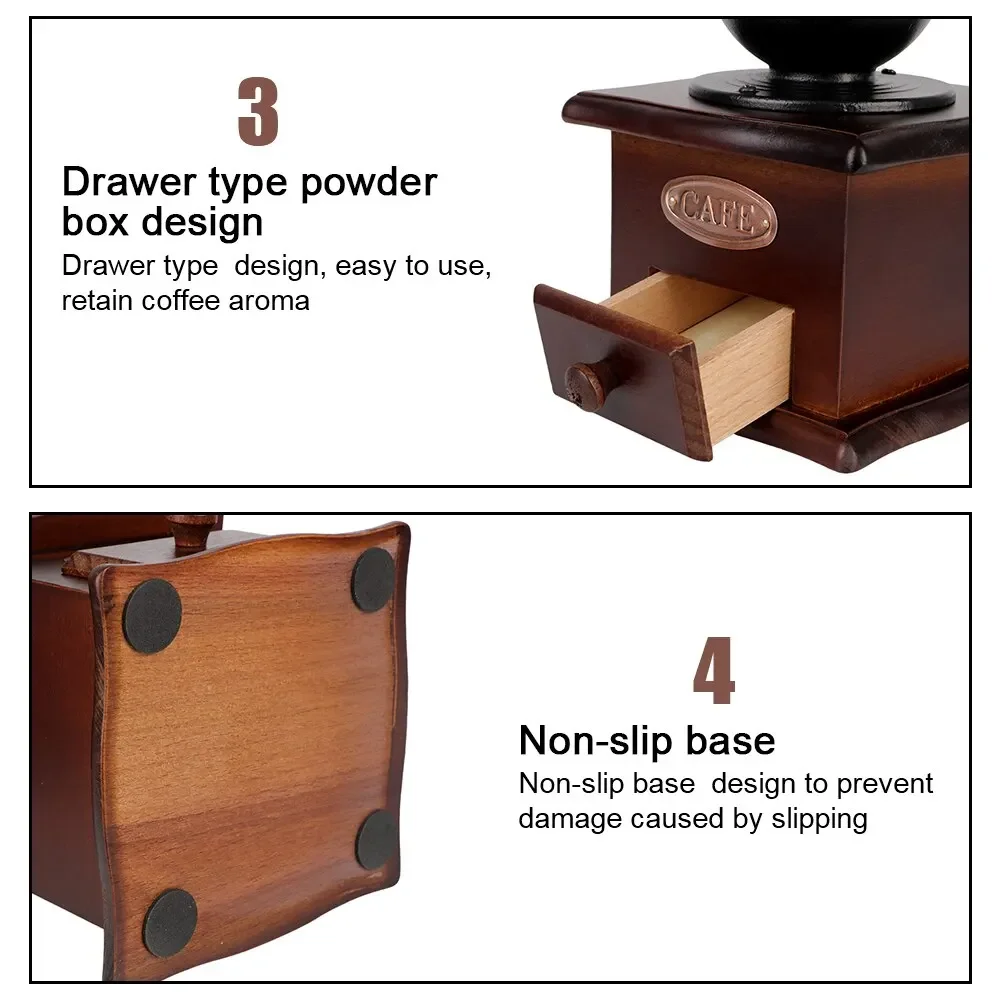
For detailed maintenance guidance, manual burr coffee grinder cleaning resources provide step-by-step processes specific to different models.
Step 3: Deep Inspection Process
If basic maintenance doesn’t solve the problem:
– Carefully disassemble your grinder according to manufacturer guidelines
– Thoroughly examine burrs for wear patterns and damage
– Check adjustment mechanisms for wear or looseness
– Inspect less visible areas for coffee buildup
Step 4: Systematic Testing
Isolate variables to pinpoint the problem:
– Try different beans to rule out bean-related issues
– Test multiple grind settings to check for setting-specific problems
– Grind the same amount of coffee multiple times to check for consistency
– Document improvements after each adjustment
Effective Solutions: Restoring Your Grinder’s Consistency
Once you’ve identified the causes, apply these targeted solutions:
Professional-Level Cleaning Techniques
For thorough cleaning:
1. Disassemble your grinder according to manufacturer instructions
2. Remove visible grounds using a soft brush
3. Clean burrs with a specialized grinder brush or unused toothbrush
4. For stubborn residue, use grinder-safe cleaning tablets or uncooked rice
5. Avoid water on metal burrs to prevent rust
6. Ensure complete drying before reassembly
7. Reassemble carefully, maintaining proper alignment
Burr Replacement and Maintenance
When replacing burrs:
1. Source exact replacement burrs from the manufacturer
2. Follow precise installation instructions
3. Properly calibrate after installation
4. “Season” new burrs by grinding a small amount of coffee
5. Adjust as needed after initial break-in
Alignment Techniques and Calibration
To improve alignment:
1. Find true “zero point” where burrs just touch
2. Check for even contact using the marker method
3. Adjust burr carrier position if your grinder allows it
4. Set proper calibration at zero before adjusting to desired setting
Savor Suite offers a selection of premium hand burr grinders designed with precise alignment features for consistent grinding results.
Operational Improvements
To reduce static and improve operation:
1. Try the Ross Droplet Technique (RDT)—adding a tiny drop of water to beans
2. Ensure stable grinder placement during operation
3. Use a dosing funnel to improve grounds distribution
4. Clean the grounds path regularly to reduce retention
Maintenance Schedule: Preventing Future Consistency Issues
Implement this maintenance routine to maintain consistency:
Daily Maintenance Practices
- Brush visible grounds from the burrs and grounds chamber
- Keep the grinder exterior clean
- Store in a clean, dry environment
- Use fresh, properly stored beans
Weekly Maintenance Tasks
- More thorough brushing of burrs and grinding path
- Check adjustment settings for drift
- Inspect for early signs of buildup
- Monitor grind times for changes indicating issues
Monthly and Quarterly Maintenance
- Deep clean burrs and all accessible components
- Check alignment and calibration
- Inspect for wear patterns on burrs
- Test consistency across multiple settings
For espresso enthusiasts, exploring manual espresso grinders with simplified maintenance requirements can help maintain consistency with less effort.
Annual Maintenance Consideration
- Complete disassembly and thorough cleaning
- Evaluate burr condition for potential replacement
- Lubricate mechanical components if recommended
- Consider professional servicing for expensive equipment
When to Upgrade: Signs Your Grinder May Need Replacement
Sometimes, upgrading is the most practical solution:
Irreparable Consistency Issues
- Burr mounting systems that cannot maintain alignment
- Motor or drive mechanisms with fundamental flaws
- Cost of repairs approaching replacement cost
- Discontinued parts for older models
Key Features for Consistency in a New Grinder
- Precision-machined burrs with tight tolerances
- Solid burr mounting systems that maintain alignment
- Low retention design to prevent mixing of old and new grounds
- Stable adjustment mechanisms that resist drift
- Consistent speed during operation
Realistic Expectations
- Entry-level burr grinders ($50-150) provide basic consistency
- Mid-range grinders ($150-300) offer significant consistency improvements
- High-end grinders ($300+) provide consistency for demanding brewing methods
- Even the best grinders require proper maintenance
Frequently Asked Questions About Grinder Consistency
Can I use soap to clean my grinder?
Generally, avoid using soap on grinders. Soap residue can affect coffee flavor and may damage some components. Instead, use specialized grinder cleaning products or dry cleaning methods with brushes.
How often should burrs be replaced?
For home use, steel burrs typically last 500-1,000 pounds of coffee, while ceramic may last slightly longer. Professional environments may require replacement every few months, but home users might go years before needing replacement.
Do light roasts really dull burrs faster?
Yes, light roasts are denser and harder, causing more wear on burrs over time compared to dark roasts. This is especially noticeable with ceramic burrs, which are more prone to chipping with hard beans.
Are manual grinders more consistent than electric ones?
Quality manual grinders can be more consistent than entry-level electric grinders. The absence of high-speed motors means less heat generation and vibration, potentially yielding more consistent results when used properly.
Contextual Bridge: How Grind Consistency Affects Different Brewing Methods
Different brewing methods have varying sensitivity to grind consistency:
Espresso is extremely sensitive to consistency issues. Minor variations can cause channeling, where water finds the path of least resistance through your puck, resulting in sour shots with bitter undertones.
Pour-over brewing shows inconsistency through uneven extraction, often tasting simultaneously bitter and sour, with reduced sweetness and clarity.
French press is more forgiving of minor inconsistency but still suffers from increased sediment and muddied flavors when grounds vary significantly in size.
Cold brew is the most forgiving method, as the long extraction time minimizes the impact of particle size variations.
Recognizing these impacts helps you identify when grinder issues are affecting your specific brewing method.
Is Hand Grinding Always Less Consistent Than Electric Grinding?
Contrary to popular belief, hand grinding isn’t necessarily less consistent than electric grinding. The differences are more nuanced:
Quality manual grinders with precision burrs often produce more consistent grounds than entry-level electric grinders. The slow, controlled nature of manual grinding can actually create less heat and friction, resulting in more uniform particles.
However, human factors like inconsistent cranking speed can introduce variability. Learning proper technique makes a significant difference, as explained in depth in our article on grind consistency vs. speed in manual grinders.
For many coffee enthusiasts, the direct feedback and control offered by manual grinding outweighs the convenience of electric models, especially when consistency is the priority.
Do Burr Materials Really Make a Difference in Consistency?
Burr materials significantly impact grinding consistency:
Steel burrs typically provide the sharpest cutting edges for precise particle size distribution. They excel with light to medium roasts but may generate slightly more heat during extended grinding.
Ceramic burrs retain their cutting ability for longer periods but are more brittle and susceptible to chipping if foreign objects enter the grinder. They generally produce slightly more fines than well-made steel burrs.
Titanium-coated burrs offer enhanced durability while maintaining sharpness, resulting in consistent grinding over a longer lifespan.
The quality of manufacturing and precision of the cutting edges matter more than material alone. A well-made ceramic burr will outperform a poorly made steel one, regardless of material advantages.
Can a Good Technique Overcome a Mediocre Grinder?
Good technique can certainly maximize a mediocre grinder’s potential, though it can’t completely overcome fundamental limitations:
- With blade grinders, techniques like pulse grinding and shaking can improve consistency dramatically
- For burr grinders, consistent dosing, stable positioning, and regular cleaning significantly enhance results
- Understanding your specific grinder’s quirks allows you to adapt accordingly
However, recognize the limitations:
– No technique will make a blade grinder perform like a quality burr grinder
– Even perfect technique can’t fix worn burrs or fundamental alignment issues
– Some grinders have inherent design flaws that technique cannot overcome
Focus on maximizing what your current equipment can deliver while saving for upgrades if consistency remains problematic.
Should You Adjust Your Grinder for Different Coffee Origins or Roast Levels?
Yes, different coffees often require different grinder settings:
- Light roasts need finer settings than dark roasts for the same brewing method due to their density and hardness
- Single-origin coffees may require minor adjustments between origins
- Freshly roasted beans typically need coarser settings than beans that are 1-2 weeks old
- Natural (dry) processed coffees often grind differently than washed coffees
Developing a simple system helps track these adjustments:
– Note your base setting for your most commonly used coffee
– Record adjustments (finer/coarser) required for different coffees
– Allow for aging effects by adjusting slightly finer as beans age
– Consider the specific brewing method when making adjustments
By addressing the specific causes of inconsistency and implementing regular maintenance, you can dramatically improve your coffee grinder’s performance. Remember that even small improvements in grind consistency translate to noticeably better coffee in your cup.

